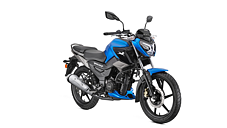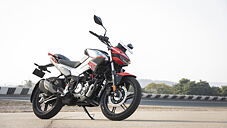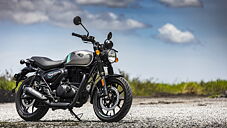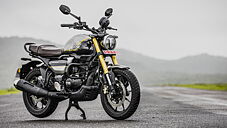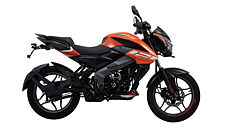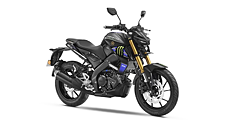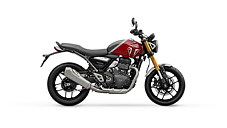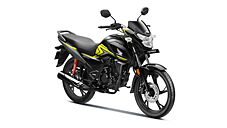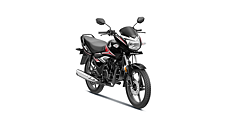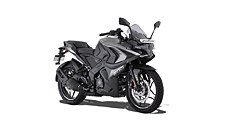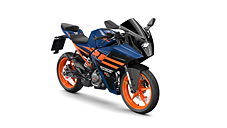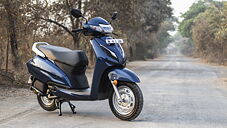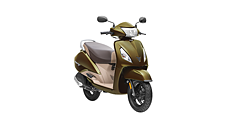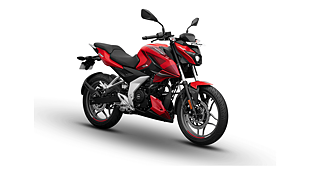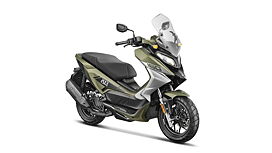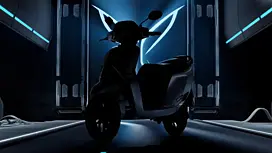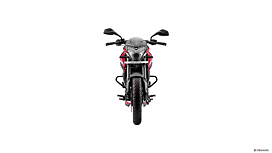Introduction

The commuter motorcycle segment has evolved by leaps and bounds in the past few years. While the CBF Stunner failed to set the cash registers ringing for Honda, it did polarise the 125cc commuter segment into two categories – executive and premium. So now, you have barebones workhorses at one end of the spectrum and more premium offerings with features likes a fifth cog and front disc brake at the other end.

Bajaj added the V12 Disc to its ‘V’ range of premium commuter motorcycles, earlier this year. It is essentially a Bajaj V15 with a smaller engine. Now, cynics might argue that this isn’t a wise move. The difference here might just be 25cc, but a 125cc buyer is quite unlike a 150cc buyer. He is a middle-class guy looking for a motorcycle that is easy on the pocket – both to buy and to run, and styling doesn’t rank high on his priority list. In fact, the buyers in this segment prefer a conservative-looking motorcycle rather than a radical one (the failure of Honda CBF Stunner would be a good example). Besides, the meager sales numbers of the V12 Disc also justify this argument.

However, we can discuss the pros and cons of this move all day long and it wouldn’t matter. For now, it is time to pit the Bajaj V12 Disc against one of the best 125cc commuter bikes in the Indian market – the CB Shine SP. Our previous comparison test between the CB Shine SP and the V15 gave us a prime example of how small commuter bikes have started punching above their weight. This time around, the CB Shine SP must prove its mettle against a more direct rival.

Looks

Bajaj has never shied away from experimenting with new styles and genres of motorcycles, and the V range is one of the most glaring examples of that. Although the intention here was to create a retro motorcycle, Bajaj ended up with a style that is quite unheard of. It has enough chrome to give it street cred while the bulky proportions give it the look of a bigger motorcycle than it actually is. The CB Shine SP on the other hand, is an evolution of the CB Shine’s design. However, it looks way more fresh and sportier than its host, while retaining the conservative essence that commuter motorcycle buyers prefer.
But I don’t want my motorcycle to blend in the background in an attempt to become invisible. I like my motorcycles to stand out. Bajaj has put in extra effort to ensure that potential buyers and fellow motorists will take more than one look at the V12 Disc. And for that, the V12 Disc gets an extra point.

Instrumentation & Riding Position

The Honda CB Shine SP is quite loaded when it comes to creature comforts. It gets a digital display for instrument cluster with a trip meter, front disc brake with optional combi braking system, tubeless tyres and preload-adjustable rear suspension. The V12 Disc on the other hand, is quite retro even when it comes to features. It gets nothing which can be termed as a creature comfort, not even a trip meter or tubeless tyres. A disc brake is the only feature it can boast of.

The V12 Disc gets a very unusual riding position, thanks to the wide and raised handlebar, low-slung seat and neutral-set footpegs, which make it comfortable for short spins. With a seat height of just 780mm, it is even easily accessible for vertically challenged riders. However, spend a respectable amount of time on the V12 Disc and you might end up with a sore back.

The Honda CB Shine SP on the other hand, gets a very typical commuter-ish riding position with an upright seating. The seat is firm and makes for a comfortable place to spend long commutes on. Subtle touches like the rubber coating on the grab rails add a premium feel to the motorcycle. Switchgear and build quality on both motorcycles is top notch.

Performance & handling

Both the Bajaj V12 Disc and Honda CB Shine SP use the same formula for the powertrain – a 124cc single-cylinder, air-cooled engine mated to a five-speed transmission. However, this is where the similarities end. The way these engines have been tuned couldn’t have been more different.

The V12 Disc has been tuned to offer a flat and rather undramatic torque curve. There is abundant grunt from the word go. However when you whack open the throttle, the V12 Disc will gather pace rather calmly. The CB Shine SP, on the other hand, seems to pack a surge of testosterone as if it is always in ‘Sport’ mode. The burst of initial torque means that getting your front wheel up by popping the clutch seems like child’s play. Being juvenile has never been this much fun! But this is a distraction from what the CB Shine SP is actually meant to do – sane-minded commuting, which is also taken care of with equal proficiency.

While the V12 gets a five-up gear pattern, the CB Shine SP gets a sportier one-down four-up pattern. The first three ratios are short on both the bikes, while the fourth and fifth are tall. Both can manage 30kmph in the fifth gear. However, the CB Shine SP feels livelier in such situations thanks to its immediate throttle response and the punchy low-range torque.

As for the ride quality, the V12 is more stiffly sprung than the CB Shine SP. While the slow speed ride feels bumpy, the V12 offers better insulation from the shocks as the speed increases. The CB Shine SP on the other hand, gets a softer suspension setup. It does a brilliant job of absorbing all the bumps and potholes in the city, and is equally adept at high speeds. The CB Shine SP also feels quick on its feet, err tyres, while filtering through traffic. The light weight, quicker steering, narrow profile tyres and the riding ergonomics make the CB Shine SP a fun motorcycle to commute on. The smaller turning radius means that getting into tight parking spots is also easier.

The front disc brake on the V12 has a good initial bite and stopping power, though it could do with better progression. The CB Shine SP, on the other hand, offers a good mix of progression and feel, although the initial bite could have been better. Overall, I like the CB Shine SP’s setup better, because it gives you a lot more confidence to go aggressive on the brake. This is also down to the soft front dive of the front suspension and the MRF Nylogrip Zapper tyres on the CB Shine, which are sticker than the Ceat Gripp tyres offered on the V12.

What was surprising was the refinement levels on the V12. Bajaj engines are known for a lot of things, but refinement isn’t one of those. However, with the V12, there are hardly any vibrations while doing city speeds. While this is expected from the CB Shine SP, it being a Honda, experiencing this kind of smoothness on a Bajaj was a pleasant surprise. For both the bikes, it is only when you go past 70kmph in fifth gear that vibrations creep in through the handlebar, footpegs and the fuel tank.
Verdict

The Bajaj V12 Disc is priced at Rs 73,197, which makes it a fantastic value-for-money proposition against the Honda CB Shine SP, which retails at Rs 75,497 (both on-road, Mumbai). Opt for the CBS system and you will have to shell out an additional Rs 2,200. The V12 Disc is stylish, refined and a welcome change in the world of boring and mundane commuter motorcycles. If you can live without all the creature comforts and don’t mind the stiff ride, then it still makes sense to go for the V12. The CB Shine SP however, makes for a perfect package. It is modest, thrifty and not too flamboyant, quite like the virtues you would associate with a typical Indian middle class buyer.

Photography by Kapil Angane
Final Scores
| Parameters | Max Points | Honda CB Shine SP | Bajaj V12 Disc |
| Rank | 1 | 2 | |
| Looks & styling | 10 | 5 | 6 |
| Ergonomics & Quality | 10 | 6 | 5.5 |
| Features & Tech | 10 | 4.5 | 3.5 |
| Engine & Gearbox | 10 | 6 | 5 |
| Performance | 10 | 6 | 5 |
| Ride Quality | 10 | 6.5 | 5.5 |
| Handling & Braking | 10 | 7 | 5.5 |
| Fuel Efficiency | 10 | 8 | 8 |
| Price & Warranty | 10 | 7 | 8 |
| Desirablility | 10 | 3 | 3 |
| Total | 100 | 59 | 55 |
Specifications
| Make | Honda | Bajaj |
| Model | CB Shine SP | V12 Disc |
| POWER TRAIN | ||
| Engine Type | Air-cooled | Air-cooled |
| Capacity | 124.7cc | 124.5cc |
| Max Power7 | 10.1bhp | 10.5bhp |
| Max Torque | 10.9Nm | 10.3Nm |
| Gearbox | 5 speed | 5 speed |
| Clutch | Wet, multiplate | Wet, multiplate |
| CYCLE PARTS | ||
| Chassis | Diamond | Double cradle |
| Supension F | Telescopic | Telescopic |
| Suspension R | Dual spring with preload adjust | Dual Spring |
| Brakes F | 240mm Disc | 240mm Disc |
| Brakes R | 130mm Drum | 130mm Drum |
| Tyre F | 100/80-18 Tubeless | 2.75-18 Tube type |
| Tyre R | 700/80-18 Tubeless | 100/90-16 Tube type |
| MEASURES | ||
| Fuel Tank | 10.5litres | 13litres |
| LxWxH | 2007mm x 762mm x 1085mm | 2040mm x 785mm x 1066mm |
| Wheelbase | 1266mm | 1315mm |
| Kerb Weight | 123kg | 133kg |
| COST | ||
| Price (on-road, Mumbai) | Rs 75,497 | Rs 73,197 |
| Warranty | 2 years/24,000kms | 2 years/30,000kms |
Gallery
1/46
Bajaj V12 Disc vs Honda CB Shine SP Action
Double Tap to Zoom



















![[object Object] ThumbNail Images [object Object] ThumbNail Images](https://imgd.aeplcdn.com/642x361/bw/ec/30664/Bajaj-V12-Disc-Action-105445.jpg?v=201711021421&wm=2&q=80)
![[object Object] ThumbNail Images [object Object] ThumbNail Images](https://imgd.aeplcdn.com/642x361/bw/ec/30664/Bajaj-V12-Disc-Action-105446.jpg?v=201711021421&wm=2&q=80)
![[object Object] ThumbNail Images [object Object] ThumbNail Images](https://imgd.aeplcdn.com/642x361/bw/ec/30664/Honda-CB-ShineSP-Action-105447.jpg?v=201711021421&wm=2&q=80)
![[object Object] ThumbNail Images [object Object] ThumbNail Images](https://imgd.aeplcdn.com/642x361/bw/ec/30664/Honda-CB-ShineSP-Action-105448.jpg?v=201711021421&wm=2&q=80)
![[object Object] ThumbNail Images [object Object] ThumbNail Images](https://imgd.aeplcdn.com/642x361/bw/ec/30664/Honda-CB-ShineSP-Action-105449.jpg?v=201711021421&wm=2&q=80)



